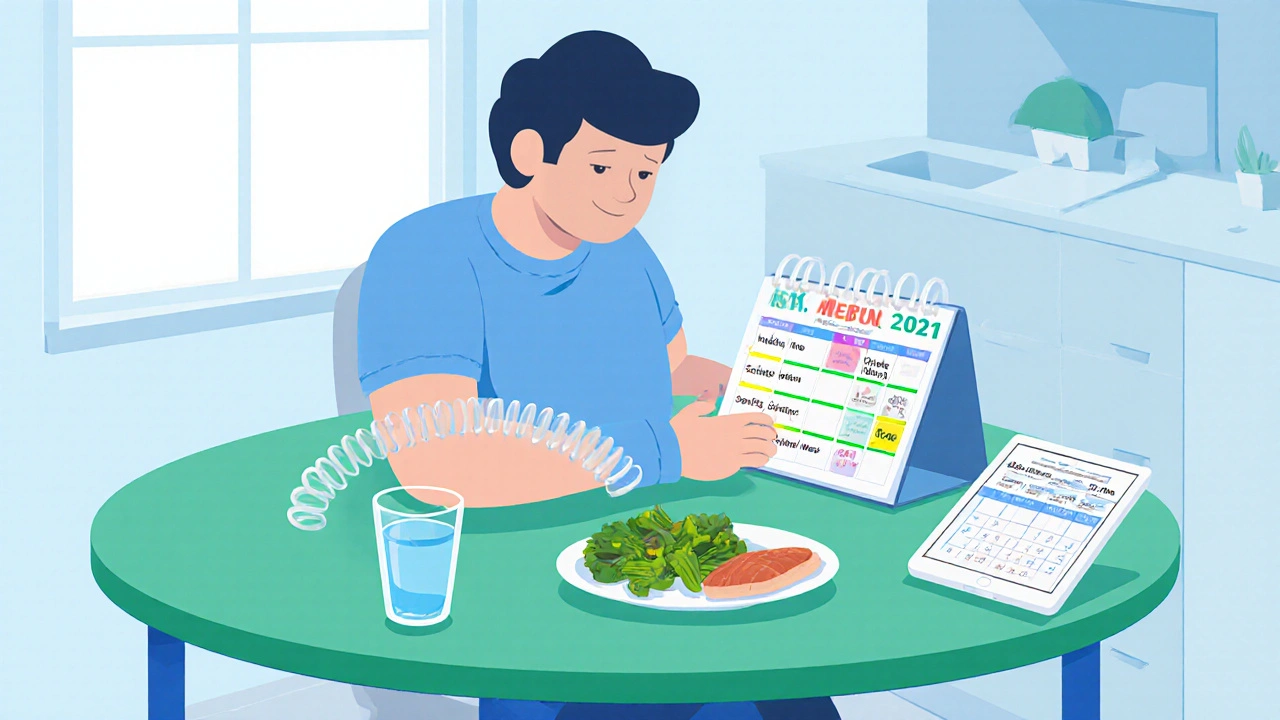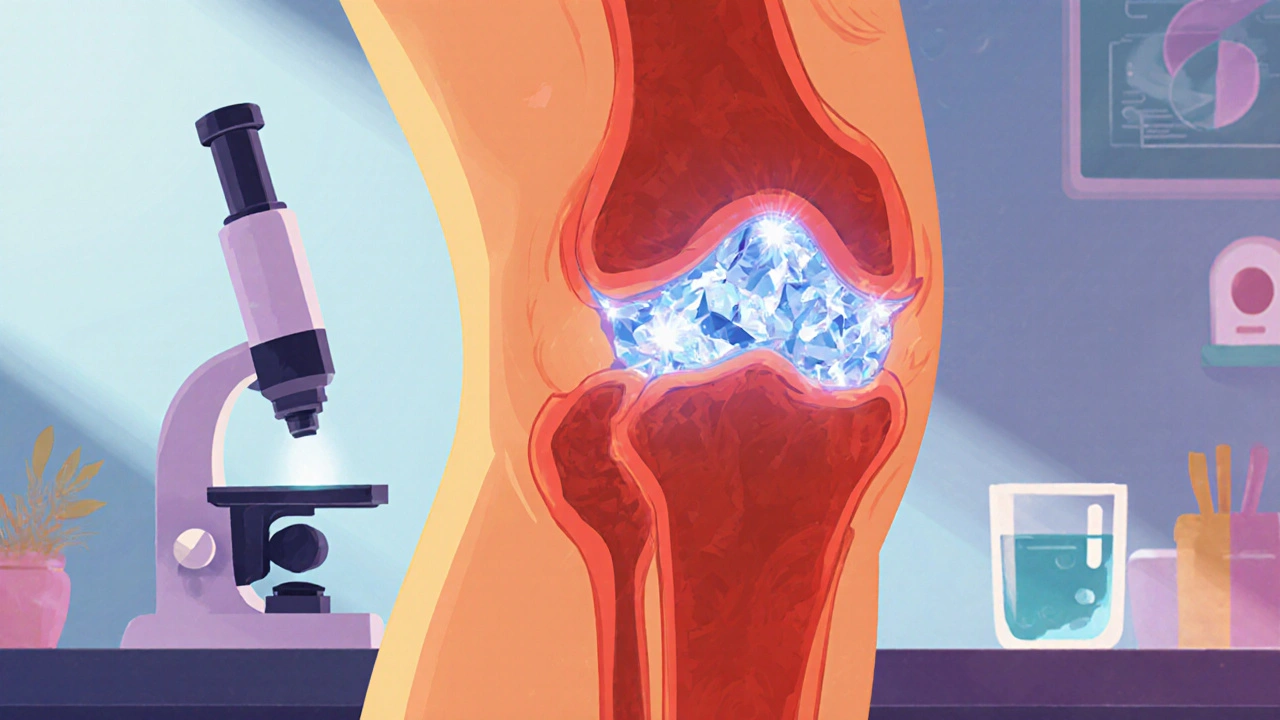Allopurinol Effectiveness Calculator for Pseudogout
This calculator helps determine if your uric acid levels indicate potential benefit from Allopurinol when managing pseudogout. Based on clinical evidence, Allopurinol is most effective for patients with hyperuricemia (uric acid > 7 mg/dL) who also have pseudogout.
People diagnosed with pseudogout often wonder whether the same drugs that tame gout can also calm their joint flare‑ups. In particular, Allopurinol gets a lot of attention because it lowers uric acid, but does it really help when calcium pyrophosphate crystals are the culprit?
What Is Pseudogout?
Pseudogout is a type of crystal‑induced arthritis caused by the deposition of calcium pyrophosphate dihydrate (CPP‑D) crystals in the joint space. Unlike gout, which involves monosodium urate crystals, pseudogout attacks tend to affect larger joints such as the knee, wrist, or shoulder. Symptoms mimic gout: sudden swelling, warmth, and sharp pain that can last days to weeks.
Risk factors include aging, prior joint trauma, metabolic disorders like hyperparathyroidism, and chronic kidney disease (CKD). The diagnosis is confirmed by joint aspiration, where the fluid shows positively birefringent, rhomboid‑shaped CPP‑D crystals under polarized light microscopy.
How Allopurinol Works
Allopurinol is a xanthine oxidase inhibitor that blocks the conversion of purines into uric acid. By reducing serum uric acid levels, it prevents crystal formation in gout. The drug is often paired with Febuxostat, another xanthine oxidase inhibitor, when patients cannot tolerate allopurinol.
Allopurinol does not dissolve existing calcium pyrophosphate crystals, but some clinicians prescribe it to lower uric acid because hyperuricemia can coexist with CPP‑D disease, potentially worsening inflammation.
Evidence on Allopurinol for Pseudogout
Large randomized trials for pseudogout are scarce, so most guidance stems from retrospective studies and expert opinion. A 2022 cohort of 312 patients with CPP‑D arthritis showed that those on long‑term allopurinol experienced fewer recurrent attacks compared to untreated peers (23% vs 45% over two years). However, the benefit was most pronounced in patients who also had elevated uric acid (>7 mg/dL).
Conversely, a 2020 case‑control analysis found no significant difference in attack frequency when serum uric acid was normal. The takeaway? Allopurinol may help a subset of patients-particularly when hyperuricemia or gout co‑exists-but it isn’t a universal solution.
When Doctors Prescribe Allopurinol for Pseudogout
- Persistent hyperuricemia (>7 mg/dL) despite lifestyle changes.
- Documented history of gout alongside pseudogout.
- Frequent pseudogout flares that impair daily activities.
- Renal impairment that limits NSAID use, making a urate‑lowering strategy attractive.
Before starting, clinicians assess renal function because allopurinol dose‑adjusts for creatinine clearance. The drug is also checked against potential drug interactions, such as with azathioprine or mercaptopurine, which share metabolic pathways.
Dosage and Monitoring
Typical starting dose is 100 mg daily, increased by 100 mg every 2-4 weeks until target serum uric acid <6 mg/dL is reached. In patients with CKD (eGFR <30 mL/min), the maximum is usually capped at 300 mg.
Monitoring includes:
- Baseline serum uric acid, liver enzymes, and renal function.
- Follow‑up labs at 2-4 weeks after dose adjustments.
- Check for hypersensitivity rash, especially in the first 3 months.
Patients are advised to stay well‑hydrated and avoid high‑purine foods (red meat, organ meats, certain seafood) to complement the medication.
Potential Side Effects and Risks
Allopurinol is generally safe, but notable adverse events include:
- Skin rash ranging from mild erythema to severe Stevens‑Johnson syndrome (rare, >0.1%).
- Gastrointestinal upset - nausea, diarrhea.
- Hepatotoxicity - elevated transaminases.
- Hypersensitivity in patients with HLA‑B*58:01 allele, more common among Asian ancestry.
Because the risk of severe skin reactions is linked to genetics, many U.K. clinics now screen for HLA‑B*58:01 before prescribing allopurinol to high‑risk groups.
Alternatives and Complementary Strategies
If allopurinol isn’t suitable, doctors may turn to other options:
- NSAIDs (e.g., ibuprofen, naproxen) for acute pain control.
- Colchicine - effective for both gout and pseudogout, but dosage must be reduced in renal impairment.
- Corticosteroids - intra‑articular injection or oral taper for severe inflammation.
- Joint aspiration with corticosteroid injection - provides rapid relief and confirms crystal type.
- Lifestyle modifications - weight management, low‑purine diet, adequate hydration.
Emerging research on magnesium supplementation suggests it may inhibit CPP‑D crystal formation, though robust clinical data are still pending.

Practical Tips for Patients
- Keep a symptom diary: note joint involved, pain intensity, and any triggers.
- Stay consistent with medication - missed doses can cause uric acid spikes.
- Schedule regular blood tests: your doctor will adjust dosage based on uric acid and kidney function.
- Report any rash or fever immediately - early detection of hypersensitivity prevents serious outcomes.
- Combine medication with non‑pharmacologic measures: low‑impact exercise, joint-friendly footwear, and balanced diet.
Remember, managing pseudogout often requires a multi‑pronged approach. Allopurinol can be a useful piece of the puzzle, but it works best when paired with proper monitoring and lifestyle care.
Quick Comparison of Common Pseudogout Treatments
| Medication | Mechanism | Typical Use | Pros | Cons |
|---|---|---|---|---|
| Allopurinol | Xanthine oxidase inhibition (lowers uric acid) | Long‑term urate‑lowering, especially with co‑existing gout | Reduces recurrence when hyperuricemia present | May cause rash, requires renal dose‑adjustment |
| NSAIDs | COX inhibition (anti‑inflammatory) | Acute flare relief | Rapid pain control | Gastro‑intestinal risk, contraindicated in CKD |
| Colchicine | Microtubule disruption (reduces neutrophil activity) | Acute attacks and prophylaxis | Effective at low doses | Diarrhea, dose‑adjust for renal disease |
| Corticosteroids | Broad anti‑inflammatory | Severe or refractory flares | Fast symptom control | Blood sugar elevation, osteoporosis with long use |
| Joint Aspiration + Injection | Physical removal + local steroid | Diagnose & instantly relieve | Confirms crystal type, immediate relief | Invasive, infection risk |
Frequently Asked Questions
Can allopurinol prevent pseudogout attacks?
It may reduce recurrence in patients who have high uric acid levels or concurrent gout, but it does not dissolve existing calcium pyrophosphate crystals.
How long does it take to see a benefit?
Serum uric acid usually drops within 2-4 weeks, but a noticeable decrease in pseudogout flare frequency may take 3-6 months of consistent therapy.
Is it safe to use allopurinol with kidney disease?
Yes, but the dose must be reduced based on eGFR. Patients with severe CKD are usually started at 100 mg daily and titrated cautiously.
What are the warning signs of a serious allergic reaction?
Fever, widespread rash, blistering, or mucosal ulcers should prompt immediate medical attention. These could signal Stevens‑Johnson syndrome.
Should I stop allopurinol during an acute pseudogout flare?
No. Continuing allopurinol helps maintain lower uric acid and may prevent future attacks. Acute pain is usually managed with NSAIDs, colchicine, or steroids instead.
 Sep, 22 2025
Sep, 22 2025

Michael Kusold
September 22, 2025 AT 21:37i've seen a few folks try allopurinol for their knee pains, but honestly it feels like a gamble sometimes.
some end up with fewer flare‑ups, others notice nothing.
Jeremy Lysinger
October 7, 2025 AT 03:37yeah, the trick is to verify hyperuricemia first; if your uric acid's normal, the drug's just a placebo.
otherwise, you might spare yourself an extra pill.
Nelson De Pena
October 21, 2025 AT 09:37Allopurinol primarily inhibits xanthine oxidase, thereby reducing serum uric acid.
In patients who have concurrent gout and pseudogout, lowering uric acid can indirectly lessen inflammatory episodes.
However, calcium pyrophosphate crystals are not dissolved by urate‑lowering therapy.
Thus, its benefit is most evident when hyperuricemia coexists with CPP‑D disease.
Wilson Roberto
November 4, 2025 AT 15:37When we examine the relationship between crystal arthropathies, we uncover a tapestry woven from metabolism, aging, and joint health.
Pseudogout, unlike its cousin gout, arises from calcium pyrophosphate dihydrate, yet both share the common pathway of acute inflammation.
Allopurinol enters the scene as a xanthine oxidase inhibitor, a tool designed to curtail uric acid production.
Its primary intent was never to dissolve calcium crystals, but clinicians have observed ancillary effects in mixed presentations.
In patients harboring both hyperuricemia and CPP‑D, the drug may dampen the overall inflammatory milieu.
The literature, sparse though it may be, hints at reduced recurrence rates when serum uric acid exceeds the conventional threshold.
A 2022 cohort reported a drop from 45% to 23% in flare frequency among allopurinol users with elevated uric acid.
Conversely, in normouricemic individuals, the same benefit was not statistically discernible.
Therefore, the therapeutic calculus must weigh the presence of hyperuricemia against the potential risks of long‑term medication.
Renal function, drug interactions, and patient tolerance remain pivotal considerations.
Dose titration begins at 100 mg daily, with cautious increments, especially in those with compromised clearance.
Monitoring serum uric acid and renal markers provides a feedback loop that guides safe escalation.
From a mechanistic standpoint, lowering uric acid may reduce the activation of innate immune pathways that cross‑react with CPP‑D crystals.
While this hypothesis is appealing, it remains an extrapolation pending rigorous randomized trials.
In practice, clinicians should individualize therapy, reserving allopurinol for patients with documented hyperuricemia or concomitant gout, rather than casting it as a universal antidote for pseudogout.
Narasimha Murthy
November 18, 2025 AT 21:37While the narrative sounds compelling, the data set you cite is retrospective and lacks a control arm, which undermines causal inference.
The observed reduction could simply reflect regression to the mean rather than a pharmacologic effect.
Moreover, prescribing allopurinol without clear hyperuricemia may expose patients to unnecessary adverse events.
Clinical prudence would dictate reserving the drug for cases where uric acid levels are demonstrably high.
Thus, the enthusiasm for a blanket recommendation appears premature.